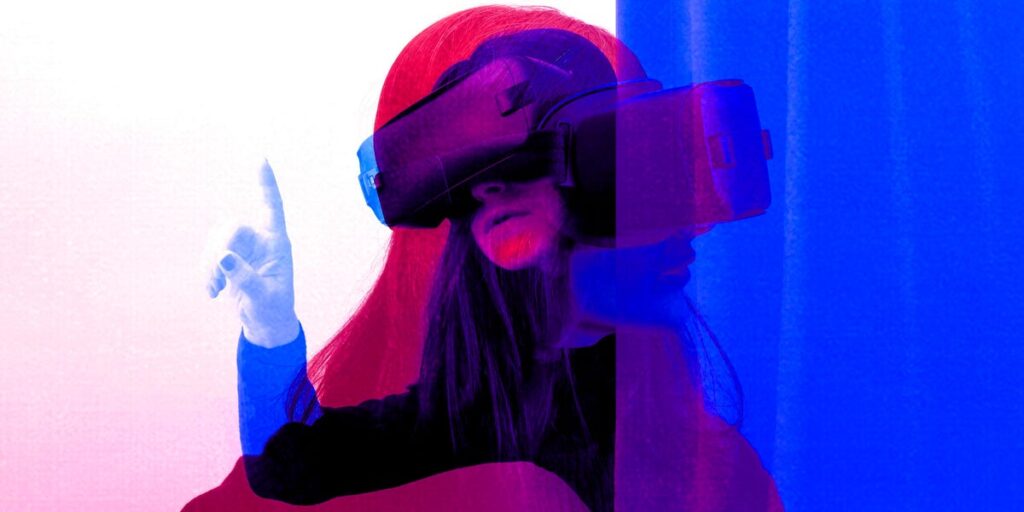- Some researchers are advocating the benefits of VR therapy for psychosis treatment.
- A clinical trial showed VR therapy reduced anxiety and agoraphobia in people with psychosis.
- This article is part of “Build IT,” a series about digital-tech trends disrupting industries.
In May 2022, Daniel Freeman, a psychology professor at Oxford University, published the results of a landmark clinical trial. For years, Freeman had been developing and fine-tuning the use of gameChange, virtual-reality cognitive-therapy software. Guided by a virtual coach, users walk through a series of everyday scenarios, from getting on a bus to stepping into a coffee shop, rating their fear levels at every stage.
The trial included 346 people with psychosis, who often experience severe anxiety and agoraphobia.
“Psychosis is not a mental illness but a symptom that appears as part of different mental illnesses,” said Kai Conibear, the author of “The Myth-Busting Guide to Psychosis,” out later this month. These mental illnesses include, but are not limited to, schizophrenia, bipolar disorder, and post-traumatic stress disorder.
Anywhere from 15 to 100 people out of 100,000 develop psychosis annually, according to the National Institute for Mental Health. Conibear pointed to the widespread perception that people with psychosis are inherently violent.
“In reality, most people who are psychotic are extremely vulnerable,” he said. “They’re more likely to hide away and isolate themselves than be out on the street running around and making noise, but that’s what draws media attention.”
Freeman’s trial specifically focused on people suffering “extreme agoraphobic avoidance” as a result of psychosis. The treatment is a kind of exposure therapy, in which a virtual therapist guides users through stressful scenarios to help alleviate their fears and regulate their thoughts.
The study found that participants who used the gameChange software experienced significantly less distress and avoidance, reporting that they felt less threatened in their environments. The more severely anxious patients experienced the greatest benefits, researchers said. These results were deemed so successful that last year, the UK’s National Health Service approved gameChange as a treatment option.
The use of VR in healthcare stretches back to the early 1990s, when it was first tested as a treatment for anxiety. It’s taken a while, but researchers are steadily building a case to prove that VR — especially in combination with more traditional therapeutic methods — can exponentially improve the lives of people with psychosis.
The barrier to VR treatments
Kim Bullock, a Stanford University researcher who studies neuropsychiatrics, said she only learned about VR advancements through her own research. “I found out there was 30 years of evidence that none of us ever heard about in training,” she told Business Insider.
Bullock is one of several researchers documenting the growing number of trials measuring the effectiveness of VR as a supplementary tool in both the diagnosis and treatment of psychotic disorders. Bullock was part of a team behind a systematic review published last summer that delved into 23 research articles across 14 countries.
In these studies, VR was used to treat everything from anxiety and social skills to paranoid delusions, often with the help of more conventional mental-health techniques, like cognitive-behavioral therapy. The study authors highlighted the “common misconception” that people with psychosis might be harmed by VR experiences because avatars or voices could mimic their hallucinations.
By contrast, the authors wrote, “VR methods may reduce symptoms and improve physical health, quality of life, and psychosocial functioning,” especially when teamed with other therapeutic treatments and medication. They described VR as a “valuable tool to potentially improve clinical outcomes, including medication adherence, motivation, and rehabilitation.”
There’s a growing body of research that demonstrates the efficacy of VR treatment, yet Bullock described healthcare providers as a “cautious group by nature.” She added, “We don’t get trained in VR, we don’t have the ability to try it out, and there are no set standards and best practices.” Bullock described this caution — rather than cost or logistics — as the main barrier to VR treatments.
In his book, Conibear interviewed eight people who’ve experienced psychotic symptoms. Many of them, Conibear said, talked about the misconception that “people with psychosis are inherently dangerous and violent.” It’s a persistent stereotype and one that results in severely ill people being violently detained rather than offered treatment and support.
How a VR experience is raising awareness
Treatment aside, VR is being used to educate and raise awareness of what psychosis actually looks like. Hong Kong’s Mind Space Museum is tucked away inside Castle Peak Museum, in the Tuen Mun District. In August last year, the museum opened up four different “symptom experience rooms,” which allow visitors to experience simulated psychosis courtesy of VR.
With the aid of goggles and headsets, visitors can experience how it feels to walk through everyday places, such as libraries and markets, with hallucinatory voices in their heads and visual apparitions flashing before their eyes.
After the VR exercise, visitors are offered a “sharing session with our peer-support workers” who experience psychosis themselves, Dr. Jessica Wong, the cochair of the hospital’s Institute of Mental Health Executive Committee, said. These support workers chat about their personal experiences with psychosis, further breaking down myths about mental illness.
This combination of VR tech and face-to-face interaction is designed to foster “empathy, understanding, and education around mental health,” Wong said. “It’s about reducing stigma and promoting mental-health literacy. Ultimately, the visitors leave with the realization that people experiencing mental-health challenges are no different than anyone else.”
Despite reluctance among US healthcare providers, researchers in the UK, Hong Kong, Canada, and elsewhere are building a convincing case for VR treatment. Conibear is on board. “Most of the currently available treatment is either medication or therapy, so this is a really interesting alternative,” Conibear said. “I love the idea that you can be exposed to these situations, but then you come out of the simulation and you’re in a safe place with everything you need to calm down.”
When compared to new medications — and their potential for side effects — Conibear believes there’s little to deter people with psychosis from trying VR out. “I really feel like this is how technology should be used,” he concluded. “There should absolutely be more of it.”
Read the full article here
















